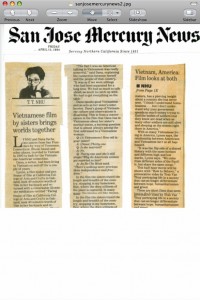
San Jose Mercury News | Friday, April 15, 1994
Vietnamese film by sisters brings worlds together
by T.T. Nhu
Lynne and Dana Sachs, two sisters from San Francisco by way of Tennessee, Connecticut, Rhode Island and other places, traveled to Vietnam in 1992 to look for the Vietnamese-American connection.
Dana, a writer, had been living in Vietnam on and off for a couple of years.
Lynne, a filmmaker and professor of film at Califonia College of Arts and Crafts in Oakland, took 40 minutes worth of film in her backpack and returned with a remarkable 33-minute meditation entitled “Facing Vietnam: Which Way Is East,” which will be shown at the Cinématheque of the San Francisco Art Institute on Sunday at 7:30 p.m.
“The fact I was an American talking to Vietnamese was really powerful,” said Dana, explaining the connection between herself and the people of that country. “It was as if we were siblings who had been separated for a long time. We had so much to talk about, so much to catch up with. We had to get everything on the table.”
Dana speaks good Vietnamese and so acts as her sister’s interlocutor. Dana’s grasp of Vietnamese culture and observations is disarming. This is from a conversation in the film that Dana has in Vietnamese about her sister’s marital status, a burning question that is almost always among the first adressed to a Vietnamese woman:
Q: (A Vietnamese) How old is your sister?
A: (Dana) Thirty-one.
Q: Is she married?
A: No.
Q: Thirty-one and she’s still single! Why do American women get married so late?
A: As Ho Chi Minh said: “There’s nothing more precious that independence and freedom.”
In the film the sisters travel the length and breadth of the country, stopping in my hometown. Hu, where the deep stillness of the place is captured. In many ways, the images are like impressionistic paintings – Van Gogh going wild in the bamboo groves.
The disjointedness captured in the film reflects what it feels like to arrive in a faraway country – new sights and sounds and, in this case, paralyzing heat. But the film also has a sense of intimacy.
In one scene the sisters work through feelings of guilt about a war they had nothing to do with. Greeted by a one-legged man at a pagoda who tells Dana that he’d like to go to America where business is good, she puts her hands together in a gesture of prayer and apologizes to him. He tells her it doesn’t matter, “like we’re talkin about a mistake I made years ago that he’s ling since forgotten.”
Still Hoa, a friend to the filmmakers, has a piercing insight about a country she has never seen. “I think I understand homelessness…but I don’t understand why your government spends so much money trying to find the bodies of soldiers that they know are dead when so many other soldiers are still alive and sleeping on the streets right there in America.”
With so many Vietnamese living in America, Lynne says, the relationship bewteen Americans and Vietnamese isn’t at all haphazard.
“It was the flip side of a shard history with the same horizon and different high and low marks, Lynne says. “We come from different sides of he Pacific, but share the same ocean.”
This half-hour movie will be shown with “How to Behave,” a provocative video by Tran Van Thuy portraying life in a society that can no longer differentiate between hope, humanitarianism and greed.
These are short films that seem long in the best sense of the word.

